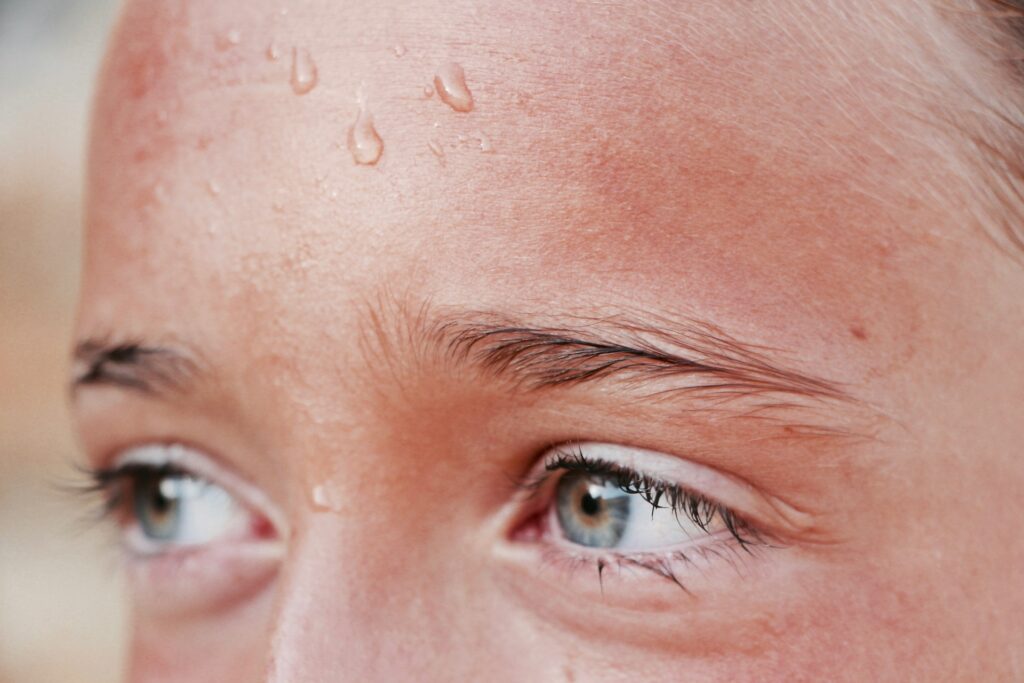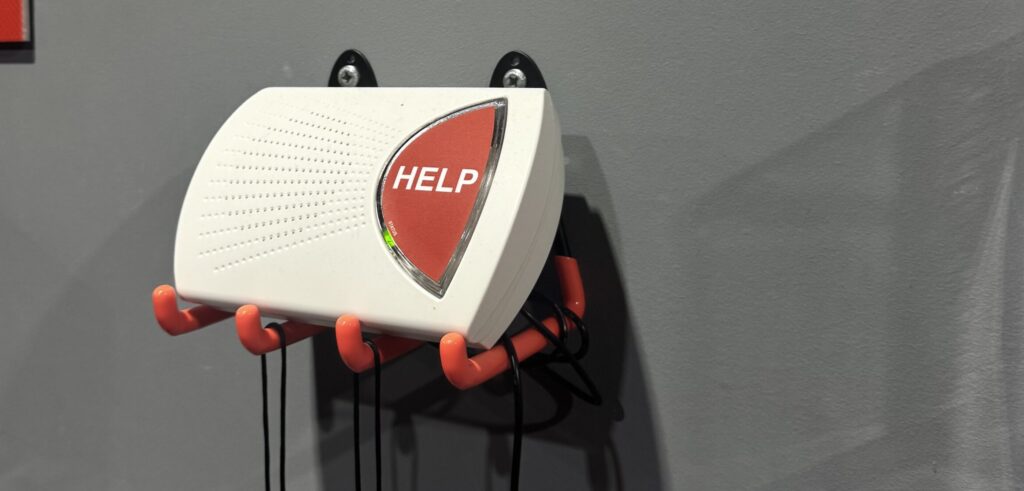News Team member Justine Borgia explores strides in healthspan research geared to help humans live healthier for longer.
The Heated Workout Trend Causing Young Adults to Sweat More Than Ever
Humans have relied on heat to boost mood for centuries, but experts warn this trend could be dangerous without proper preparation.
By Stephanie Oehler
Addie Travis used to dread working out. Her body constantly felt worse walking out of the gym than walking in. This frustration led the 20-year-old Emory University student to search for an alternative. She booked a free trial class at Hotworx, a 24-hour fitness studio that specializes in virtually-instructed heated workouts in infrared saunas.
Travis’ workout routine looks vastly different now than when she was using a standard gym. Three times a week, she cranks up a Hotworx sauna to 125°F and follows a virtual instructor for a 30-minute Pilates, core, or glutes-targeted class. “The initial appeal for me was burning more calories in very little time, but as I got into it more, I realized it’s not just about burning calories,” Travis said. “I actually feel amazing afterward. I feel happier. I feel like my body is more flexible.”
Travis is now a sales associate at the Hotworx Atlanta-Decatur franchise, located about a mile away from Emory University. This studio is one out of 700 locations established since the first opened in February 2017. The rapid expansion of the Hotworx franchise to 300,000 active members mirrors the rising popularity of heated workouts among young people.
Heated workout classes, once limited to hot yoga, have now expanded to include other forms of exercise such as hot Pilates, rowing, cycling, HITT, and barre. Heated fitness studios lure customers with claims of detoxification, increased calorie burn, improved mood, pain relief, and muscle recovery. Research on heated exercise supports some of these claims; however, experts warn that the potential benefits must be carefully considered along with the risks.

“If you put somebody in an environment that they have not adapted to, you have to be very, very careful,” said Dr. Dan Benardot, a professor at Emory University and a fellow of the American College of Sports Medicine who has served as the nutritionist for several US Olympic teams. Exercising in the heat can lead to increased blood volume and improved fat-burning capacity. It also can result in heat stroke, muscle loss, and severe dehydration without proper hydration and nutrition, he added.
Heated fitness studios like Hotworx are exploding in popularity among young people, leaving skeptics questioning if heat is a workout game-changer or another fitness fad.
The human desire for extreme heat is not new. Hot springs, steam rooms, and saunas have been used for thousands of years across cultures, from Finland to Indigenous American tribes, for relaxation, therapy, and spiritual rituals.
It wasn’t until the 1970’s, however, that heat became intentionally incorporated into indoor exercise routines. Bikram Choudhury, an Indian-American yogi, popularized hot yoga in the United States after opening his first studio in 1974. Bikram’s yoga classes rest at 104°F for 90 minutes, designed to mimic the hot and humid climate of India.
Stephen Smith, the founder and CEO of the Hotworx franchise, credits a Bikram yoga class as his inspiration for creating Hotworx. Smith states in his online blog that his intention with Hotworx was to build upon the hot yoga model and make traditional workouts such as Pilates, bands, isometric, HIIT, and cycling more efficient with infrared heat.

Physiological Effects of Heated Exercise
Hotworx prominently features the slogan “More workout, less time” in its marketing, promoting that heated workouts enhance workout efficiency by forcing the body to adapt to extreme conditions.
Exercising in the heat places significant physiological demands on the body. The average resting core temperature is 98.6°F, but if it rises above 104°F, the risk of heat-related illnesses dramatically increases. Exercising in a 125°F degree room, however, doesn’t mean the body’s core temperature will reach that level. The internal core temperature may only heat to around 101-102°F if the body’s cooling mechanisms are successfully working.
“The standard strategy the body has to cool itself is to sweat more,” Benardot said. “When sweat evaporates off the skin, it removes heat in the process.”
The body must work harder to maintain homeostasis in extreme heat. Sweating increases, causing the heart to beat faster and pump more blood per beat to push fluid, oxygen, and nutrients to cells throughout the body. This adaptation can improve fat metabolism as the body adapts to heated exercise. The number of mitochondria per cell and the number of oxidative enzymes per mitochondria may increase due to greater levels of oxygen in tissues, resulting in an improvement of the body’s fat-burning capacity.
“People who work in the heat are often able to maintain their blood sugar better, and their body fat tends to go down because they’re burning more to satisfy their energy requirements,” Benardot said.
The high energy demands of heat exposure, however, also decrease levels of stored glucose. Exercise performance can suffer without proper nutrition before a heated workout.
Most people only think about drinking water, but sweating also causes the body to lose salt and sugar. The body will compensate by breaking down muscle if all three aren’t replenished, Benardot said.
Additionally, prolonged heat exposure, especially in a dehydrated state can put individuals at risk for heat-related illnesses such as heat stroke and rhabdomyolysis.
Heat stroke occurs when the body’s sweating mechanisms fail, often due to dehydration, and the body’s core temperature continues to rise above 104°F, resulting in symptoms such as confusion, seizures, coma, and death.
Rhabdomyolysis occurs when high amounts of substances, such as proteins and electrolytes, are released into the blood from damaged muscle tissue. Symptoms include seizures, dangerous heart rhythms, kidney damage, and even death. Staying well hydrated can significantly lower the risk of rhabdomyolysis.
Experts note that, while heated workouts can improve metabolic efficiency, they require careful planning to ensure that the body is properly fueled and hydrated so that it is capable of handling the stress of high temperatures. Benardot recommends drinking fluids that contain electrolytes like sodium chloride (salt) to replenish the water and electrolytes lost through sweat. He also suggests that eating or drinking a small amount of carbohydrates before a heated workout can help maintain energy levels and protect muscle mass.

The Appeal of Heated Workouts to Young Adults
Workout studios like Hotworx primarily attract young women in their twenties and thirties. Plenty of workout studios offer effective classes at room temperature without the added risks of heat exposure, but something about the heated environment keeps young adults coming back for more.
Social media likely plays a significant role in driving this trend. The search term “heated workout” on TikTok or Instagram yields thousands of posts. A study published in the International Journal of Environmental Research and Public Health in November 2022 found that social media fitness influencers can significantly influence the motivation of young women to exercise through sharing their exercise routines. Social media posts advertise heated workouts with the promise of more results in less time, catering to a younger generation raised on instant gratification.
Social media may drive people to try heated workouts, but the effect of heat on mood could be what gets people to stick around.
“Why do people pay good money to go do something like yoga in a miserable environment? And not only do they pay to do it, but they get addicted to it,” said Dr. Charles Raison, a visiting professor in Emory University’s Center for the Study of Human Health and professor of human ecology and psychiatry at the University of Wisconsin–Madison. “Exercise is an antidepressant. Heat is an antidepressant. It makes sense that by combining them—you might get more bang for your buck.”
Raison has done extensive research on the effects of using hyperthermia– the process of heating the body’s core temperature to approximately 101.3 degrees– as a treatment for depression. Hotworx CEO, Stephen Smith, even cited one of Raison’s studies on his company’s blog.
A randomized, double-blind study by Raison and his colleagues, published in JAMA in August 2016, used an infrared hyperthermia machine to induce whole-body hyperthermia in 30 individuals. Participants who received whole-body hyperthermia had a greater reduction in depressive symptoms than the placebo group.
“The systems in your brain and body that control your body temperature overlap extensively with systems that are implicated in how you feel, in your mood,” said Raison. “This is why people have been doing saunas and steam rooms and hot springs for thousands of years, across hundreds of cultures. High, time-limited heat exposure induces states of mind that people find to be beneficial,” he added.
Raison’s studies have exclusively been on heat but have not included an exercise component. He emphasizes that, while the idea of combination of heat and exercise may be beneficial, more studies need to be done specifically on fitness studios like Hotworx. “No one has really studied intense heated sauna workouts, so they can make overblown claims,” Raison said.

Misinformation and Safety Concerns
The fitness industry is notoriously difficult for consumers to navigate, and heated workouts are no exception. New workout studios pop up with flashy claims and promises that sound almost too good to be true.
“People are drawn to heated exercise right now because it’s new and it’s unique,” Benardot said. “But people get hooked on things before they really understand them.”
The promise of burning more calories in less time is made on almost all of Hotworx’s marketing materials. “You have to ask, what calories?” Benardot said. “People want to burn more fat calories, but if you’re not well-fueled and hydrated, you may be burning muscle mass instead of fat mass”, he added.
Hotworx also claims that heated workouts allow consumers to “sweat out toxins,” effectively detoxifying the body. Most experts, however, agree that this is a myth. The liver and kidneys play a much larger role than sweat in removing toxins from the body, according to the Cleveland Clinic. Sweat is made up of 99 percent water, and the other 1 percent is mostly beneficial electrolytes. A very small proportion is toxins, like heavy metals and BPA.
There are also legitimate safety concerns with the 24-hour infrared sauna fitness studio model. Hotworx locations are open around the clock, but staff members are only present during typical work hours. After hours, members enter with a personal lock code. Members who experience an emergency outside staffed hours may not be near anyone else in the studio to immediately attend to them.
Hotworx does offer members portable panic buttons that members can grab before their workout session. One press of the button will automatically call EMS to the studio. Customers may become comfortable with their heated workout routine, however, and become complacent with these safety precautions.
Ultimately, it’s up to individuals to protect themselves. Members must sign a waiver before their first session to acknowledge the risks.
Experts stress the importance of never participating in a hot workout session when dehydrated. “An easy way to determine if you’re well-hydrated is to look at urine color,” said Dr. Bernardot. If urine is darker, the body is low on fluids, he added.
Experts emphasize that more research and better consumer education on heated exercise are needed as customers fall more and more in love with the heat.
“Honestly, my goal is just to become more comfortable in my body and feel good,” Travis said. “Hotworx helps me reach that goal.”
For people like Addie Travis, who crave a challenging workout in a scorching sauna, risks can be minimized by always starting a workout well-hydrated and well-fueled, with stable blood sugar and muscle glycogen levels.
“The goal is to maintain normalcy, not to recover from an abnormal state after it’s too late,” Benardot said.
